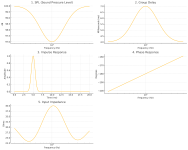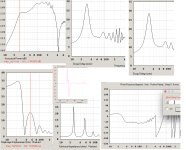Hello friends,
I have asked Chatgpt if it can give me a list of variables I should focus on to design a bass horn with good transient response for frequencies between 40 and 320 Hz. I also asked it to give me examples of how these variables would look when calculated by Hornresp and/or AKABAK. I got an answer according to the attached image. Sadly, these curves do not resemble anything I have calculated with AKABAK or Hornresp. I am a beginner at this, so I could be wrong, but I guess Chatgpt is floundering in this case. I would be very grateful if someone on this forum could show real curves of important variables, calculated from successful bass horn projects. Chatgpt said that I should look at the following variables:
Jonas
I have asked Chatgpt if it can give me a list of variables I should focus on to design a bass horn with good transient response for frequencies between 40 and 320 Hz. I also asked it to give me examples of how these variables would look when calculated by Hornresp and/or AKABAK. I got an answer according to the attached image. Sadly, these curves do not resemble anything I have calculated with AKABAK or Hornresp. I am a beginner at this, so I could be wrong, but I guess Chatgpt is floundering in this case. I would be very grateful if someone on this forum could show real curves of important variables, calculated from successful bass horn projects. Chatgpt said that I should look at the following variables:
- SPL (Sound Pressure Level) – A smooth and extended frequency response between 40–320 Hz, with no sharp peaks or dips, indicates balanced output and fewer resonances.
- Group Delay – Low (below ~10 ms) and stable group delay across the working range shows good phase alignment and fast transient response.
- Impulse Response – A sharp, narrow pulse without ringing or overshoot means accurate transient reproduction.
- Phase Response – A relatively linear phase curve indicates the speaker system is coherent and reproduces time-domain signals accurately.
- Input Impedance – Broad and moderate peaks (as opposed to sharp, high ones) suggest minimal resonant artifacts and a well-damped system.
Jonas
Attachments
They don't resemble any low frequency horn I've encountered built in the last 100 years or so.Sadly, these curves do not resemble anything I have calculated with AKABAK or Hornresp.
This is what a successful BFLH (big front loaded horn) with solid response down to 28Hz might look like:I would be very grateful if someone on this forum could show real curves of important variables, calculated from successful bass horn projects.
That FLH has 60" x 45" x 22.5" (1524mm x 1143 x 572mm)exterior dimensions.
A 40Hz FLH would not require as much path length, so could be made considerably shorter (~40") and would have flatter response.
A 40Hz TH (Tapped Horn) could be under half the size of the BFFL, but would not have extension to 320Hz, and transient response would not be quite as good.
Attachments
Some interesting articles on Kolbreks site including a bass horn he has built. He pops in to the hornresp thread with insights to queries often which can be searched as well as the topics. https://kolbrek.hornspeakersystems.info/index.php/horns/the-big-bend-bass-horn.
Chatgpt is a beginner at this too.I have asked Chatgpt...
Sadly, these curves do not resemble anything I have calculated with AKABAK or Hornresp. I am a beginner at this...

